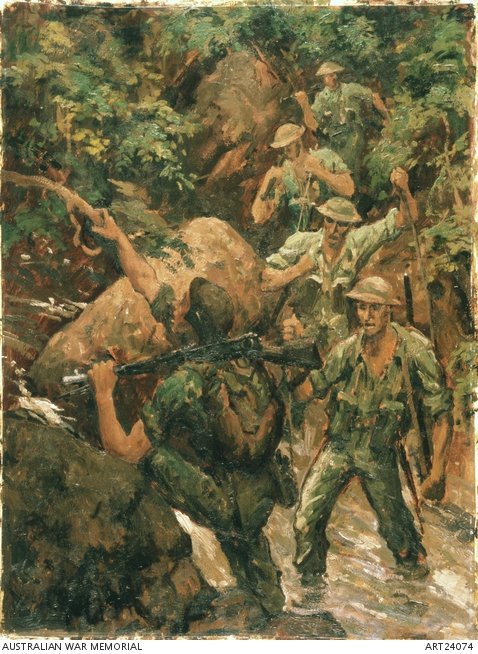Charles Mene
Corporal Charles Mene (third from left) on board SS Devonshire bound for Korea, c. 1952
Born on Mabuiag Island in the Torres Strait, Charles Mene was 24 years old when he enlisted for service in the Militia at the outbreak of the Second World War. Until February 1942 members of the Militia were allowed to serve only in Australian territory, while a separate Australian force was raised for service overseas.
In December 1939 Mene transferred to the newly formed Second Australian Imperial Force and travelled to Brisbane for training. This was the first time he had been outside the Torres Strait, but he quickly adapted, and was soon fighting in the rugged mountains of Syria as part of the 2/33rd Battalion.
Corporal Charles Mene receives the Military Medal from British High Commissioner Sir Douglas MacGillivray, c.1957
By early 1942 the Australian government was forced to turn its attention to the Pacific and the heightened threat posed in the region following Japan’s attack on Pearl Harbor in December 1941. Mene’s unit was sent to reinforce the battered and tired troops in New Guinea on the Kokoda Trail, and was later involved in the desperate battles at Gona, Ramu Valley, and Shaggy Ridge, before travelling to Balikpapan in Borneo.
In 1946 Mene was sent to Japan as part of the British Commonwealth Occupation Force (BCOF). More than 16,000 Australians served in BCOF, and at the peak of its involvement was responsible for more than 20 million Japanese citizens in an area exceeding 57,000 square kilometres. Australian troops worked alongside British, Indian, and New Zealand troops to enforce the unconditional surrender of Japan, maintain military control, and supervise the demilitarisation of the country.
While Mene was in Japan he fell in love with a local woman, and they later married. In 1950 he enlisted for service in Korea with the 1st Battalion, Royal Australian Regiment. There, his extensive combat experience saw him serve in a machine-gun platoon while occasionally leading less-experienced rifle companies in battle. On one occasion his section came under heavy artillery and mortar fire, during which Mene carried the wounded back to safety until all were out of harm’s way. In 1952 he was awarded the Military Medal for the “courage and devotion to duty” displayed during his service.
Mene went on to serve in the Malayan Emergency, where Australians fought with British Commonwealth Forces against communist guerrillas hidden deep in the Malayan jungle. In 1961, after two years in Malaya and some 22 years in the Australian armed forces, Mene was discharged and returned home to Australia. He settled in Brisbane with his wife, Michi, and daughter, Patricia, and died in 1999.
Activities for research and classroom discussion
1. For Mene, the Second World War was the first time he had been outside the Torres Strait. How do you think he may have felt as he sailed away?
2. War came perilously close to Mene’s home during the Second World War. How has Rosie Ware captured this experience in her work?
3. Painted by official war artist George Browning, this work shows Australian troops crossing a creek along the Kokoda Trail. What words would you use to describe this environment?
4. Read the citation for Mene’s recommendation for the Military Medal. What does this award suggest about the kind of soldier he was?
5. Mene served in the army for more than 20 years, including service in Korea and Malaya. Do you think it would have been difficult for him to adjust to civilian life? Why or why not?



